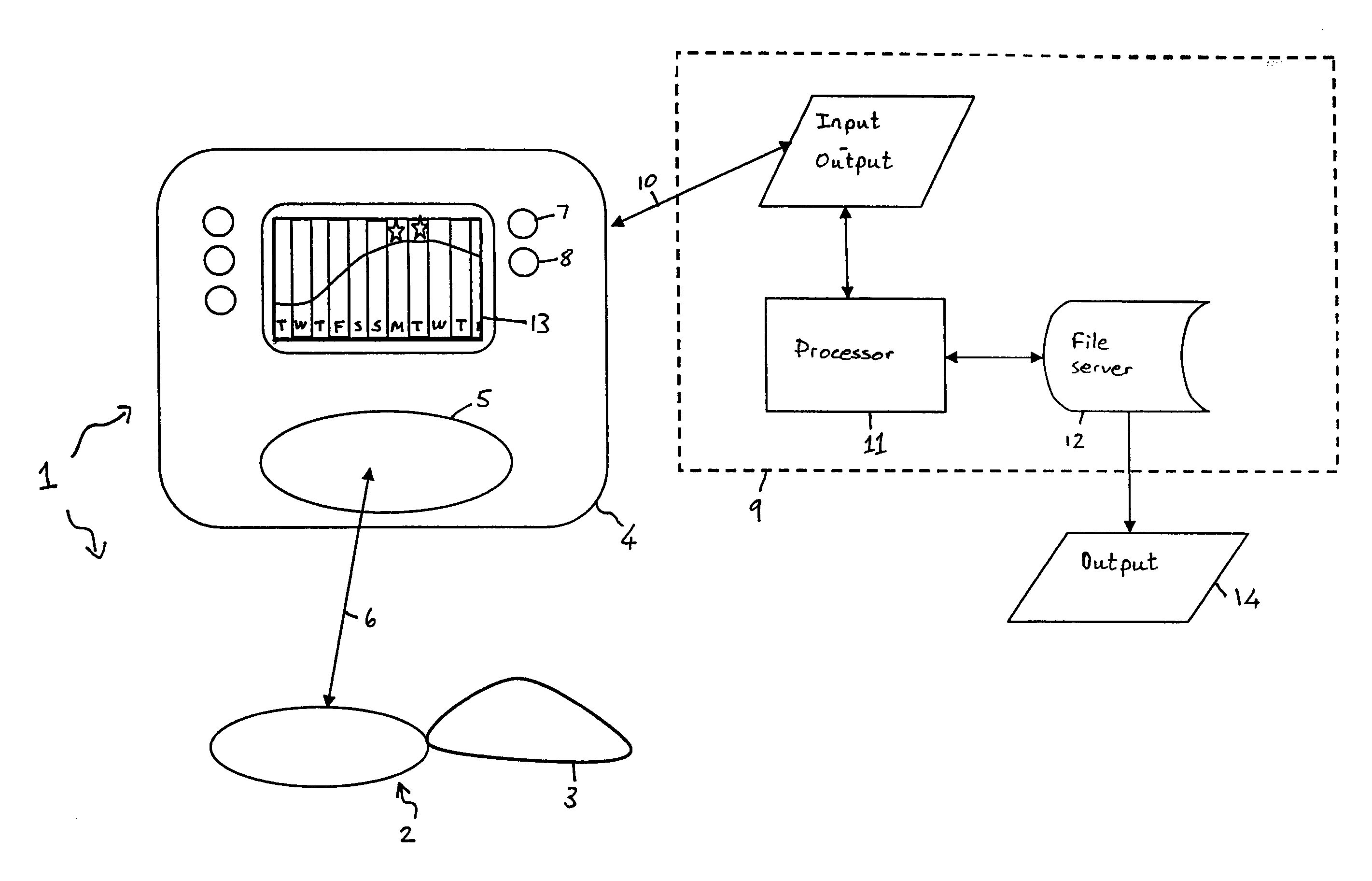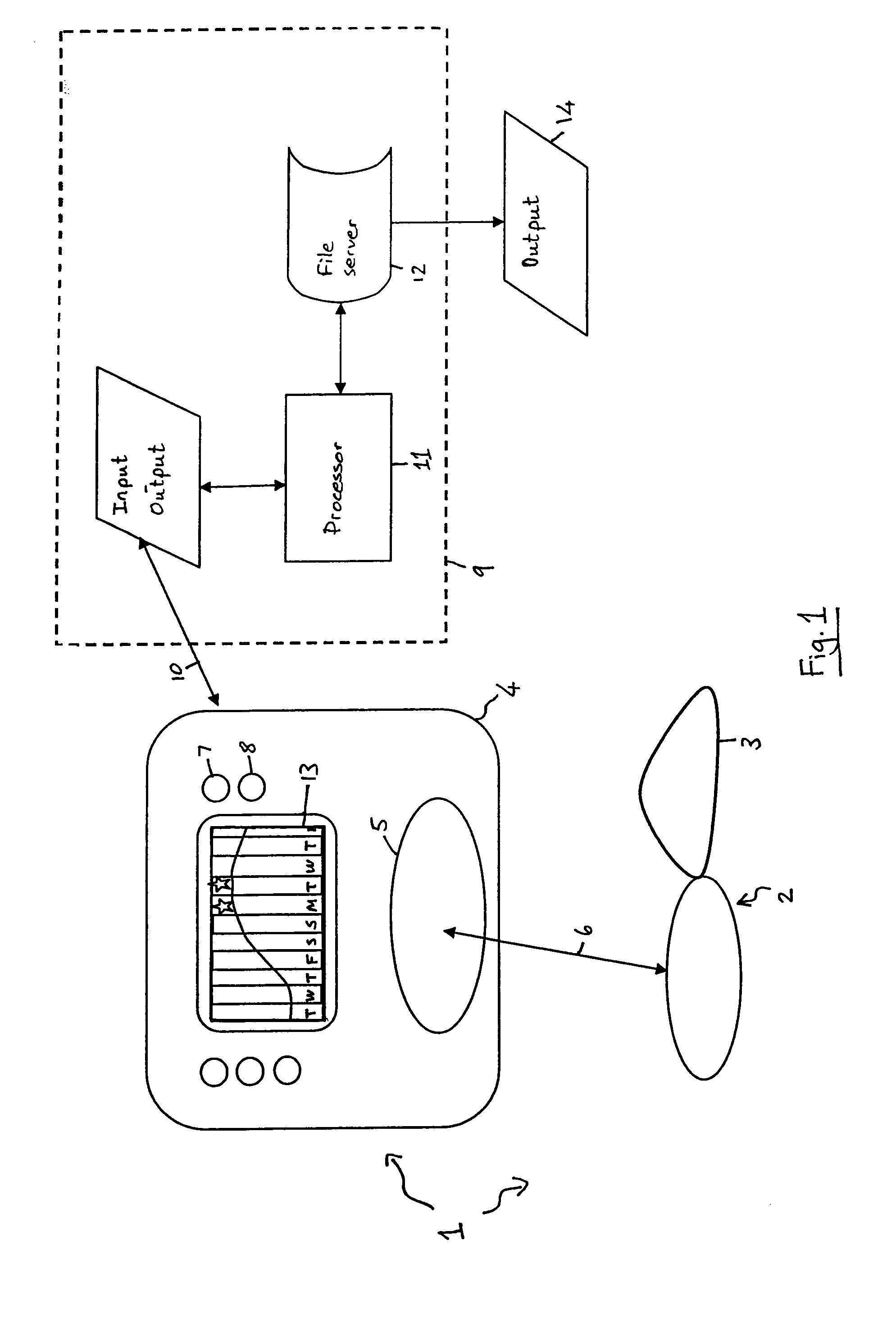Method of detecting and predicting ovulation and the period of fertility
a technology of ovulation and period, applied in the field of detecting and predicting ovulation and the period of fertility, can solve the problems of increasing the receptivity of the dominant follicle to lh, affecting the success rate of ovulation, so as to reduce the risk of unwanted side effects, increase or decrease the chance of conception, effect of improving the success ra
- Summary
- Abstract
- Description
- Claims
- Application Information
AI Technical Summary
Benefits of technology
Problems solved by technology
Method used
Image
Examples
example 1
[0214]FIG. 1 illustrates diagrammatically an apparatus and method in accordance with a certain preferred embodiment of the invention. It is to be understood that features disclosed in respect of this preferred embodiment may be applied to other embodiments of the invention.
[0215]There is provided to a female human a user terminal 1 comprising a temperature measuring device provided in an indwelling unit 2. The indwelling unit 2 is designed for intravaginal use and is smoothly shaped for comfort and hygiene. It is provided with a cord 3 for ease of retrieval. The indwelling device is used worn in the vagina every night from the first night following the end of menstruation until such time as the next menstrual period starts. The indwelling unit comprises an electronic temperature measuring means which takes multiple temperature readings at regular time intervals during the overnight period. The indwelling unit is powered by battery and comprises a memory unit which records the temper...
example 2
Day and Night Temperature Readings
[0223]FIG. 2 shows temperature readings taken every five minutes using an intravaginal indwelling temperature measuring device from an individual woman over two consecutive days (10 and 11 June). This 48 hour period encompassed both day time periods when the woman was awake and active and overnight periods when the woman was asleep—the bar at the bottom of the graph shows when the woman was awake and when she was asleep. It can be seen from the graph that the overnight temperature readings when the woman was asleep are subject to fewer fluctuations. This is because they are subject to fewer irrelevant temperature changes. This data suggests that it may be preferable to obtain representative temperature values from temperature readings obtained during an overnight time period when the woman is asleep.
[0224]The conclusion drawn from FIG. 2 is reinforced by the data shown in the table below which compares the standard deviation (SD) of temperature read...
example 3
Comparison of Alternative Representative Temperature Values
[0226]Lines A to E of FIG. 3 plot data derived from temperature readings taken every 5 minutes from an indwelling temperature recording device (“personal sensor”) placed intravaginally in a woman from day 9 to day 26 of her cycle.
[0227]In all cases the reading obtained during overnight periods was processed according to the invention to give a single representative temperature value for each day of the cycle.
[0228]Line F plots a once-daily oral temperature reading.
[0229]The woman from whom the data was derived was of normal fertility and the cycle shown was an ovulatory cycle. One therefore would expect to see first a temperature slight dip and then a temperature rise as the cycle processes.
[0230]Line F shows that the oral temperature readings show a great deal of fluctuation which is because of the influence of erroneous or irrelevant data.
[0231]Lines A and E show less of such fluctuations and therefore demonstrate the adva...
PUM
 Login to View More
Login to View More Abstract
Description
Claims
Application Information
 Login to View More
Login to View More - R&D
- Intellectual Property
- Life Sciences
- Materials
- Tech Scout
- Unparalleled Data Quality
- Higher Quality Content
- 60% Fewer Hallucinations
Browse by: Latest US Patents, China's latest patents, Technical Efficacy Thesaurus, Application Domain, Technology Topic, Popular Technical Reports.
© 2025 PatSnap. All rights reserved.Legal|Privacy policy|Modern Slavery Act Transparency Statement|Sitemap|About US| Contact US: help@patsnap.com



